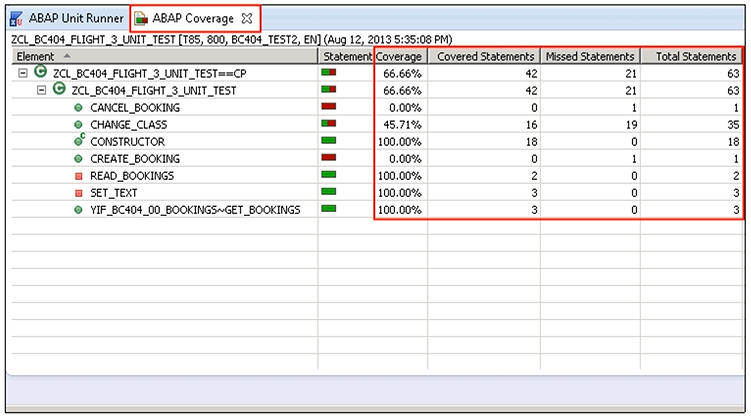Unit test with ABAP Unit
Phase Model of Unit Test and Fixture Methods
|
1 |
Start internal session for test class |
|
|
2 |
Class construction of test class |
|
|
3 |
Setup of Class Fixture (method CLASS_SETUP) |
|
|
4a |
For each Test Method: |
Create Test Class Instance |
|
4b |
Setup of Fixture (method SETUP) |
|
|
4c |
Execution of Test Method |
|
|
4d |
Teardown of Fixture (method TEARDOWN) |
|
|
5 |
Teardown of Class Fixture (method CLASS_TEARDOWN) |
|
The methods have predefined names, and are automatically called by the ABAP runtime environment when the test is executed.
Test Coverage
ABAP Unit allows you to verify the thoroughness of your unit testing and easily find any untested code.
To run ABAP Unit tests with code coverage measurement, choose Execute → Unit Tests With → Coverage from the development object’s context menu in the navigation area (ABAP Workbench) or Coverage As → ABAP Unit Test from the context menu in the Project Explorer (ADT).
The coverage that was achieved by running the ABAP Unit tests is displayed next to the test result on an additional tab page.
You can switch the display between statement coverage, branch coverage, and procedure coverage (“procedure” standing for processing block).
Hint: Coverage Analysis is much better integrated into ABAP Development Tools. Whereas, in the ABAP workbench you only see a list of numbers.

Types of Coverage
ABAP Development Tools display the coverage in the source code editor as follows:
Statement Coverage
Every executable line is highlighted either green or red. Green indicates that the statement was exceeded. Red indicates that the line was not executed.
Branch Coverage
Branches in your code are highlighted red if they were not executed. Branches are highlighted green if they were run and resolved to both true and false. Branches are highlighted yellow if they were run but resolved only to one condition, true or false.
Procedure Coverage
Procedure entry points are highlighted green or red to indicate whether they were called or not.